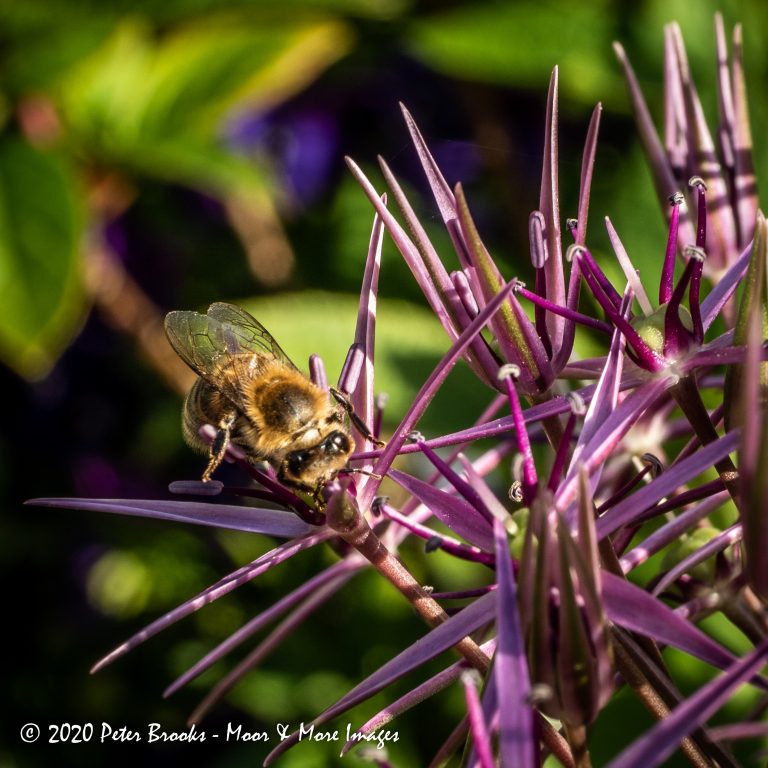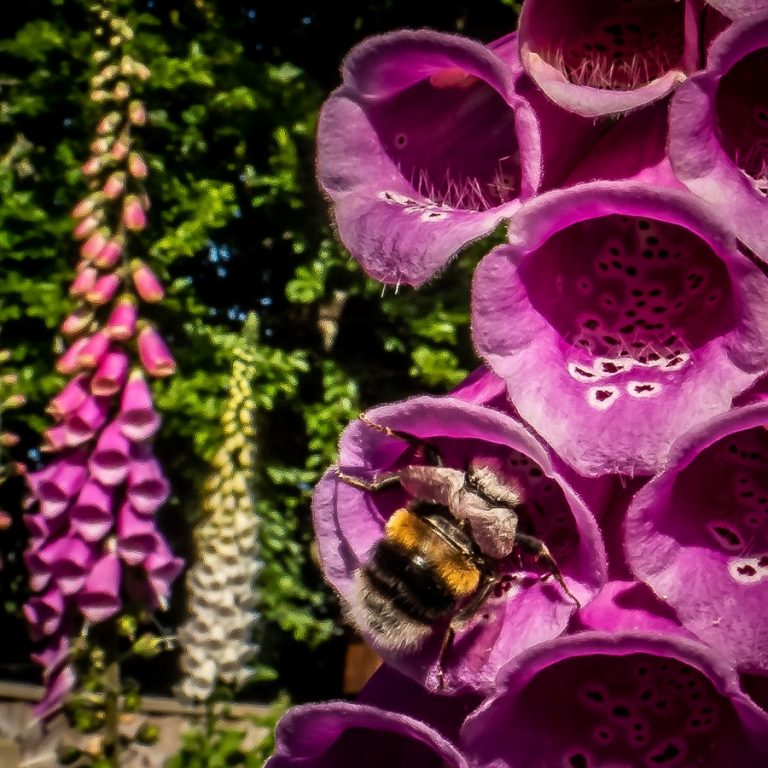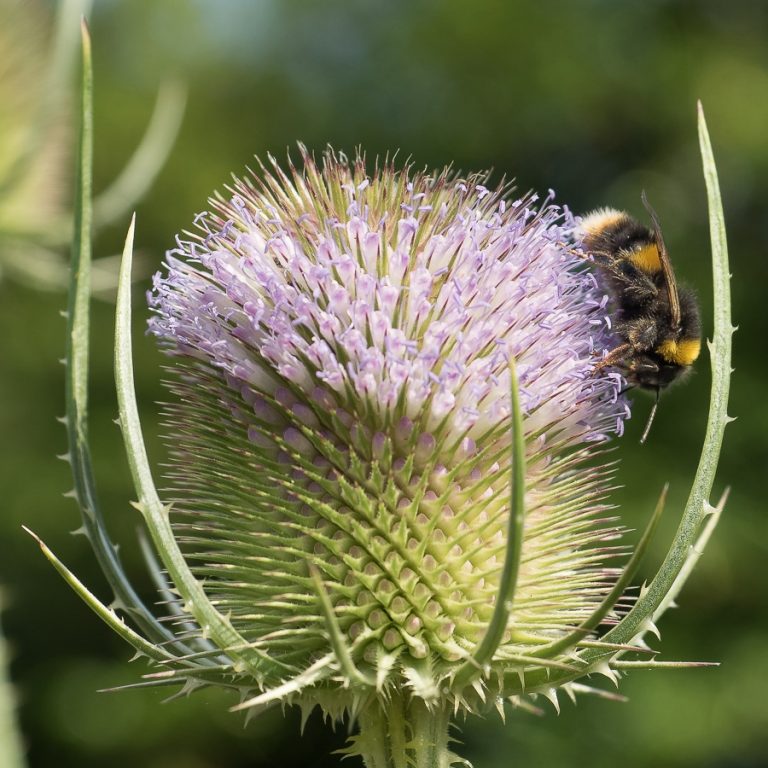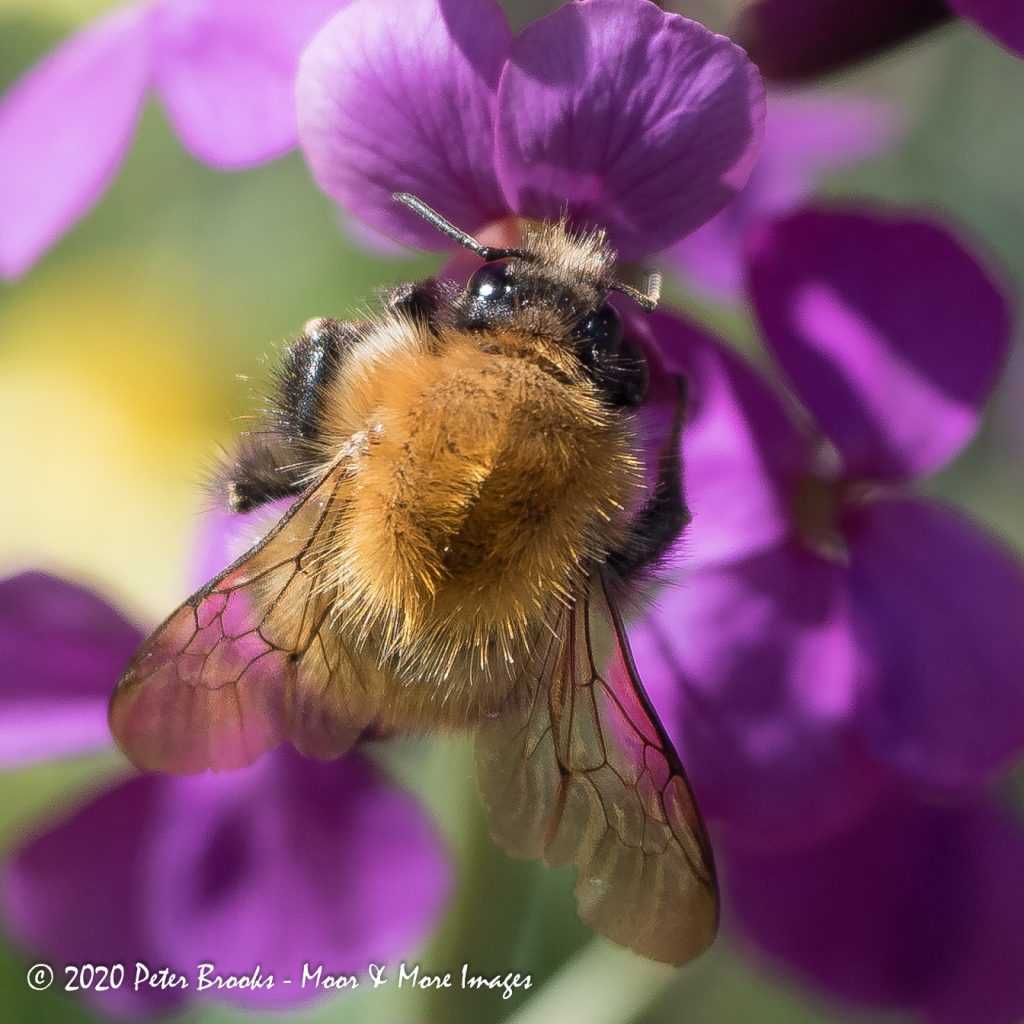Bring in the bees
Bees make great subjects and are some of the easiest insects to attract to the garden. They are extremely varied. There are around 270 species of bees in the UK, over 90% of which are solitary bees (meaning that they do not live in colonies). There are two main ways to attract bees; provide them with food and/or provide them with somewhere to nest.
Provide them with food
You do not even need a garden to attract bees. Even if you have only a balcony or a window box you can introduce a flowering plant or two that will attract them. If you are a total novice, buy a couple of well grown plants from a garden centre that you can grow in pots or a container. If you buy plants in flower, or just coming into flower, you can see what you are getting and get a quicker return on your investment. The container does not have to be fancy just as long as it will hold a decent amount of compost and has a hole or two in the bottom to allow drainage and stop the soil/compost becoming waterlogged. As a simple guide, something that will hold about a bucketful of soil is adequate for growing 2 or three plants. If you have a courtyard or a garden you will of course have more options.
Double your value
If you enjoy cooking as well as photography, some of the herbs can be a good choice and also provide something that you can use when cooking. A number of herbs are quite tolerant of dry conditions or actually prefer them, so generally they survive well in planters. They will forgive you if you occasionally forget to water them! Try rosemary, thyme, marjoram, chives, Russian sage and lavender. Honey bees are often kept in the middle of cities now, so you may well attract them to window-boxes even at the top of tall buildings.
English Lavender is a great favourite with honey bees. You can also get French lavender, but the shape of the flowers make them less accessible to bees and they are not so hardy, so select the English variety.

Flowers – keep it simple!
If you prefer to have some flowering plants, pick ones with bold colours and simple shapes. Bees will visit flowers of many colours, but they are particularly attracted to purple flowers.
Many garden plants have been selected for their good looks and scent, not because they are bee (or other insect) friendly. Complex flowers like roses are not accessible to bees. If you are uncertain, pick plants with a simple daisy-like shape. It’s also worth considering whether the flower will make a good background for your bee images and whether the flower would make a good image itself, when there are no insects around. Suitable flowers include geranium, aster, forget-me-not and single-flowered dahlias (like the one on the right)..
Complex can work too!
There are other flowers that look more complex because they have clusters of flowers but are great for attracting bees. The allium family is a good example. This family includes edible varieties like onions and chives as well as a host of different flowers. Alliums like Purple Sensation and Giganteum have amazing purple flower heads that can be six inches across. These make interesting subjects both as flowers and seed heads. Bees love them. You can buy alliums in pots for an instant fix, or plant bulbs in the autumn. They don’t need ongoing attention, just plant the bulbs and forget them until you see the amazing flowers the next year.
If you have the space, sunflowers are another ‘must have’ plant. They are annuals, meaning they grow from seed to flowering in one season. Although the monster 2-3 metre tall sunflowers certainly make a statement, they can put your photographic subjects out of reach. However, these days it is possible to get sunflowers in yellow, orange and bronze colours and different heights. So pick a variety that will suit your situation and that grows to a height that allows you to get good access with your camera.





Tubular bells!
Exceptions to the ‘keep the flower simple’ rule are some of the varieties that have tubular flowers. Varieties like snapdragon, penstemon and foxglove have tubular or trumpet shaped flowers and are great for attracting bumble bees. You can get purple varieties of these flowers to further improve their attractiveness. Select plants that are the right size for your setting. Snapdragons are small enough for window-boxes. Penstemons are taller, but can be grown successfully in containers. However, foxgloves can grow to over two metres tall, so they need a bit of space at the back of a border or against a wall.
We always grow loads of foxgloves as the bumble bees love them. They crawl inside in search of nectar and emerge dusty with pollen. Bumble bees are easier subjects to photograph than solitary and honey bees as they are slower moving and so give more opportunity to get the right shot. Foxglove flowers open in sequence, from the bottom to the top of the stem. This means that there are flowers available to the bees for several weeks. Because they are tall plants, it is also easier to get a camera in the right place. You can buy potted foxgloves at your local garden centre. If you put them in a quiet corner they will produce a mass of seed and self-set plants for the next years. Note that foxgloves are biennials. This means that if you want to grow them from seed, you have to plant the seeds in one year and they will flower in the next.
Foxgloves can look good even in the most neglected corners of a garden and a good companion for them is the humble teasel. You don’t see teasels for sale in garden centres so often, but you can buy plug plants (baby plants that you need to grow on) or seeds. Like foxgloves they grow one year and flower the next. Teasels make great photographic subjects; they attract bees while in flower and birds, particularly gold finches, when they produce seed. Beware though, they can be big plants (2-3 metres tall) and they do have some fiendish prickles, so don’t plant them where you are going to brush by them and keep them away from areas where children are likely to be playing. (see image on the left),
A flower for all seasons
If you only have limited resources try and select a few plants that will be in flower at different times of the year. Not only will this mean that you have bees in your space for much more of the year, but also that you are providing food for the bees for longer too.
Give a bee a home
Well, not actually a home, but somewhere they can nest and reproduce. Unless you are going to become an apiarist (beekeeper) you are not going to house honeybees, but you can do a lot to help the 250 species of solitary and bumble bees. If you have a wall or a solid fence that you can hang something on, consider adding a ‘bee-home’. You can buy these readymade, or you can make one yourself from simple materials like garden canes and a two litre plastic bottle. These ‘bee-homes’ will attract mason and leafcutter bees, which normally make their mini nests in holes in walls. Modern walls do not provide the same opportunities for them that old fashioned walls did, so any help you can give them will be welcome. Mason bees plaster up the entrances to their egg nursery with mud, while leaf cutter bees close off the entrance with vegetable material that they have cut from plants; roses being one of their favourite sources of ‘building material’ (see below). It is fascinating to watch and photograph them as they go about their business.
One tip that we would share is to put a wire mesh barrier in front of the bee-home. We get pied woodpeckers in our garden and we found that they regarded our bee-homes as a neighbourhood snack bar. They hung on the front of the bee-homes and used their long beaks to dig in and eat the bee larvae!



Bumble bees are harder to help.
They naturally make their small, untidy nests underground in rough grassland areas; not the sort of habitat that you find in most gardens.
However, you may be able to help them with a custom made ‘bumble-bee-home’ filled with dry grass. Take care though, as your bumble-bee-home might attract other insect ‘tenants’. We think ours has attracted a solitary wasp (see below); but until the larvae hatch we are not going to know!
There is plenty of advice on-line if you want to construct your own ‘bee-homes’ and it is an easy enough thing to do.


Photographing bees
We do not pretend to be experts on bee photography, but here are a few things to consider.
It’s worth having some tall plants (like foxgloves or sweet rocket) near your favourite seating area. Then you can sit and enjoy a drink while waiting for the bees to come to you.! You can even have a camera locked down on a tripod waiting for the bees to come into frame.
Try to arrange to have plants that will be lit by the sun at different times of day so that you can work without needing additional lighting or reflectors. Bees generally move too fast to make complex setups possible.
A shallow depth of field (F 5.6 or less) works well if you are seeing the subject from directly in front, or behind and wish to blur out the rest of its surroundings. However, if you are trying to capture the whole insect, the aperture needs to be F 8.0 or more.
If you use a zoom lens rather than a macro, zoom in as far as possible and the background will generally blur out nicely. If you can isolate the insect on a flower with nothing in the immediate background (i.e. nothing within a metre) the background usually blurs out even better.
Autofocus, even if set to ‘spot’, may not ‘fix’ the focus point that you want; so it’s worth switching to manual focus. However, you have to learn to focus fast and be prepared to find you have taken a lot of ‘download and delete’ shots, where you didn’t get the focus quite right!
Experiment with which part of the bee to make the key focal point. I usually aim for the antennae or the hairs on their back as these are the things you tend to be most aware of when you look at the image.
You have to decide whether the insect is the key element of the shot, or whether it is the flower that is your subject and the insect just an interesting component. If the insect is the key element, you don’t need to frame the shot to get the entire flower in the image. You will probably end up cropping even more of the flower out in post-processing. If the flower is the main subject the framing of the shot needs to be quite different and has to take account of the environment around the flower.
Speed is important. Bees move fast, so it’s important to keep the shutter speed as fast as possible.




